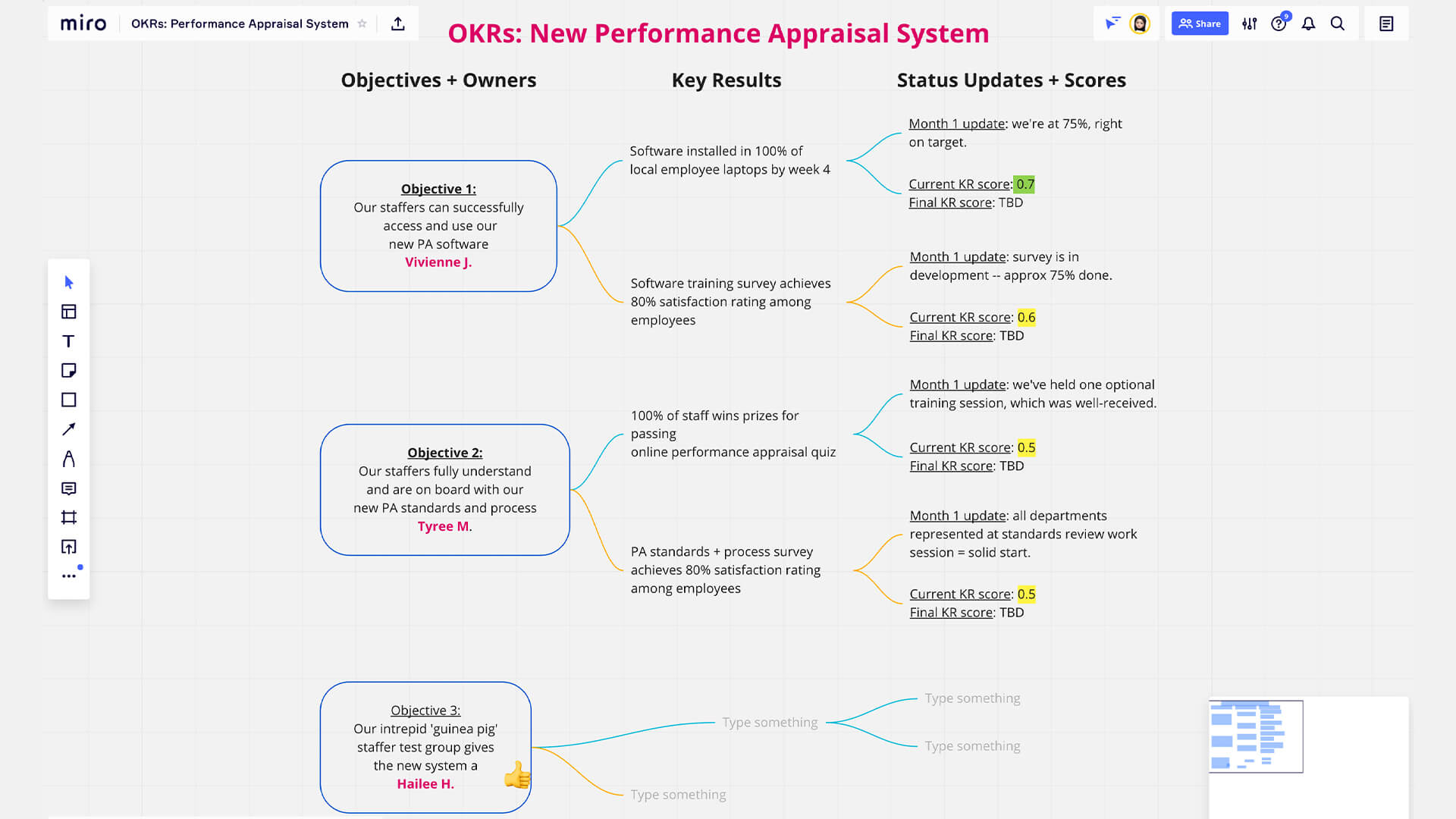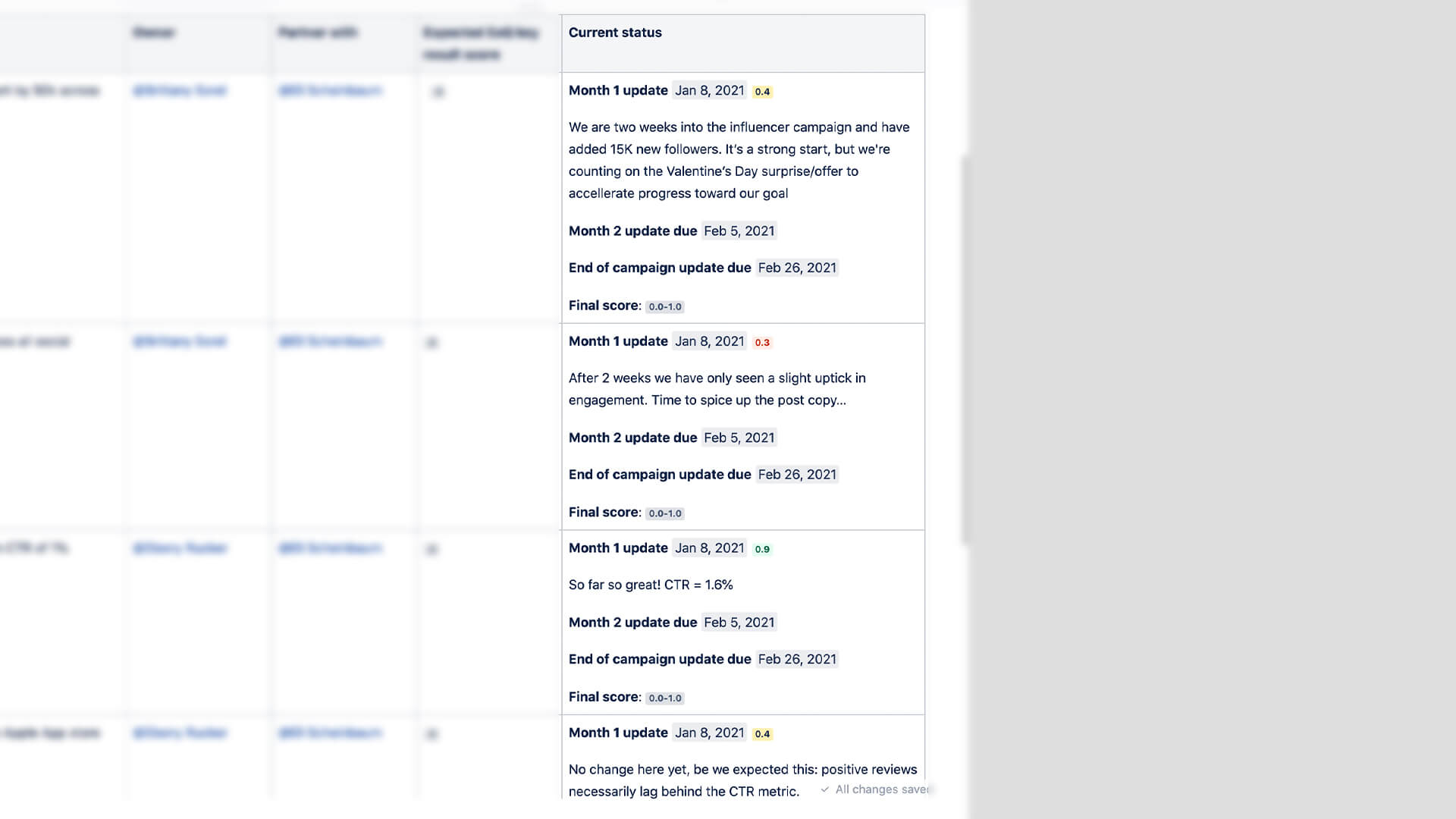Objectives and Key Results (OKRs)
Use the OKR goal-setting framework to define objectives, establish key results, and accelerate progress toward achieving your organizational and team goals.

PREP TIME
10m
Run TIME
2h
Persons
3-11
5-second summary
- Define 1-3 objectives.
- Set 3-5 key results per objective.
- Track success and score your OKRs each month.
WHAT YOU WILL NEED
- Video conferencing with screen sharing or meeting space.
- Digital collaboration tool (see templates).
- Timer.
PLAY resources
How to set OKRs
The OKR Play shares a five-step process that any team can follow to define objectives, articulate desired results, and track success with OKRs.
Les objectifs et résultats clés (OKR), qu'est-ce que c'est ?
John Doerr, qui a présenté les OKR dans son livre « Mesurez ce qui compte », décrit l'objectif comme le « quoi » et les résultats clés comme le « comment ». Découvrons cela plus en détail.
Les objectifs représentent ce que vous souhaitez accomplir et indiquent la direction ou la cible. Ils sont généralement qualitatifs, ambitieux et appellent à l'action.
Les résultats clés indiquent la manière d'atteindre les objectifs avec des résultats spécifiques et mesurables. Ils sont quantitatifs et suivent l'avancement vers les objectifs, généralement à l'aide de métriques ou d'étapes importantes claires.
Les OKR sont particulièrement efficaces lorsqu'ils sont mis en œuvre dans l'ensemble d'une organisation, car ils sont hiérarchisés entre les équipes et les personnes.
Pourquoi exécuter un scénario OKR ?
Voici deux bonnes raisons d'exécuter un scénario OKR :
- Déterminer ce qui compte : les OKR indiquent clairement quelles sont les priorités et comment votre travail contribue à la réalisation des objectifs organisationnels.
- Déterminer ce qui ne compte pas : les OKR clarifient ce qui n'est pas une priorité. Ils permettent aux équipes de se concentrer sur un ensemble limité de priorités et de rejeter les tâches qui les distraient de leur travail de base.
Les OKR alignent les équipes autour des objectifs, favorisent la transparence, encouragent la responsabilité et fournissent un framework clair pour mesurer la réussite. Lorsqu'ils sont correctement implémentés, les OKR améliorent les performances et la collaboration au sein de l'organisation.
Quand utiliser les OKR au travail ?
Les OKR sont particulièrement utiles en période de croissance, de changement, ou lorsque la transparence et la responsabilité au sein de l'organisation doivent être améliorées. Chaque année, les équipes Atlassian définissent des OKR, les actualisent tous les trimestres et suivent leur avancement tous les mois.
3 avantages des OKR
- Impact positif : 83 % des participants à l'enquête s'accordent à dire que les OKR ont eu et continuent d'avoir un impact positif sur l'organisation (OKR Impact Report 2022).
- Productivité accrue et réalisation des objectifs : les équipes qui donnent la priorité à leur travail sont 4,6 fois plus susceptibles d'être efficaces et productives (Rapport Atlassian sur l'état des équipes en 2024).
- Agilité et adaptabilité : les OKR permettent d'ajuster rapidement les objectifs, aidant ainsi les entreprises à s'adapter rapidement aux changements. En identifiant leurs principaux objectifs, les entreprises sont 4,7 fois plus susceptibles de s'adapter (Rapport Atlassian sur l'état des équipes en 2024).
1. Prep the Play
1. Préparer le scénario 5 MIN
Lorsque vous réunissez l'équipe, en personne ou à distance, envoyez un message expliquant le scénario ainsi que les raisons de son exécution. Créez ensuite un document collaboratif, comme une page Confluence. Vous pouvez utiliser les modèles fournis ou créer vos propres modèles.
Décidez en équipe de la période pour laquelle vous définissez les OKR (les OKR trimestriels sont un bon début) et partagez les informations suivantes avant d'exécuter le scénario :
- Buts et objectifs généraux de l'entreprise
- Feuilles de route de projet
- Feedback et/ou métriques des clients
-
Si disponibles, les OKR précédents
Conseil : MODÈLE EN CASCADE
Si votre entreprise n'a pas d'OKR, recherchez les initiatives stratégiques ou majeures de l'année sur lesquelles elle souhaite se concentrer. Elles documenteront les OKR rédigés en équipe.
2. Define objectives
1. Préparer le scénario 5 MIN
Demandez à l'équipe de faire un brainstorming sur les objectifs qu'elle souhaite atteindre (le « quoi ») dans un délai défini. Les objectifs doivent être qualitatifs et ambitieux, et constituer la priorité absolue de l'équipe une fois définis.
Ajoutez les idées au document collaboratif. Regroupez les objectifs similaires, puis résumez les idées en un à trois objectifs.
1. Améliorer la satisfaction client
2. Accélérer le développement produit
3. Élargir la portée du marché
4. Améliorer la productivité des équipes
5. Façonner l'avenir
6. Gagner les cœurs et les esprits
7. Devenir une entreprise d'IA
8. Susciter l'engagement pour les produits prioritaires
9. Élargir l'adoption par les équipes métier
10. Augmenter le chiffre d'affaires
3. Set key results
1. Préparer le scénario 5 MIN
Demandez à chaque membre de l'équipe d'identifier ses 3 à 5 responsabilités principales dans le cadre de ce projet dans la colonne « Responsabilités (selon moi) ».
1. Objectif : améliorer la satisfaction client
- Résultat clé 1 : obtenir un score NPS supérieur ou égal à 50
- Résultat clé 2 : réduire le temps de réponse moyen aux demandes des clients à moins de 2 heures
-
Résultat clé 3 : augmenter le taux de fidélisation de la clientèle de 10 %
2. Objectif : accélérer le développement produit
- Résultat clé 1 : lancer deux nouvelles fonctionnalités d'ici la fin du quatrième trimestre
- Résultat clé 2 : réduire le temps moyen de résolution des bugs de 25 %
-
Résultat clé 3 : augmenter le pourcentage de tests automatisés à 80 %
3. Objectif : élargir la portée du marché
- Résultat clé 1 : conquérir trois nouveaux marchés géographiques d'ici la fin de l'année
- Résultat clé 2 : accroître la notoriété de la marque de 20 % sur les marchés cibles
-
Résultat clé 3 : mettre en place des partenariats avec cinq influenceurs ou organisations clés
CONSEIL : DES RÉSULTATS, NON DES TÂCHES
Les résultats clés mesurent le travail, mais ne sont pas le travail en lui-même.
« Créer cinq pages web », est une tâche.
« 5 % d'augmentation des vues sur la page », est un résultat clé.
CONSEIL : PRÉSERVER LA QUALITÉ
Faites en sorte que les résultats clés capturent à la fois le résultat et la qualité. Par exemple, si votre résultat clé est le nombre de tickets résolus par le centre d'assistance, vous pouvez également mesurer la diminution du nombre de tickets soumis afin de garantir le maintien de la qualité de l'aide. Le but n'est pas d'atteindre le résultat clé par manque de qualité.
4. Assign owners
1. Préparer le scénario 5 MIN
Dans la colonne « Responsabilités (selon les autres) », notez les principales responsabilités correspondant, selon vous, à chacun des autres rôles.
Si une responsabilité à laquelle vous pensez ne correspond pas clairement à un rôle, ajoutez-la à la section dédiée aux responsabilités non assignées.
5. Tracking success with OKRs
1. Préparer le scénario 5 MIN
Lisez ce que les autres ont écrit à propos de votre rôle dans la colonne « Responsabilités (selon les autres) ». Ajoutez une coche (✅) si vous acceptez une responsabilité ou une croix (❌) si vous la refusez.
Ajoutez des commentaires contextuels si vous avez des questions ou des commentaires concernant les responsabilités des autres.
À la suite d'une discussion d'équipe, le titulaire du rôle passe en revue toutes les croix (❌) et décide d'assumer ou de déléguer des tâches supplémentaires. En cas de chevauchement de tâches, un propriétaire principal est désigné, ainsi que d'éventuels contributeurs ou propriétaires secondaires.
Toutes les responsabilités non revendiquées ou non acceptées sont transférées dans la section des responsabilités non assignées.
Selon la structure de votre organisation, le titulaire du rôle peut avoir besoin de l'approbation de sa direction pour finaliser son rôle, comme indiqué dans ce processus.
Follow-up
Partagez
Partagez le document final avec l'équipe pour recueillir son avis sur les éventuelles lacunes ou opportunités.
Distribuez le document des rôles et des responsabilités aux principales parties prenantes et aux principaux dirigeants en veillant à en informer l'équipe.
Prévoyez de passer en revue ce scénario avec l'équipe tous les trois ou six mois, ou à chaque changement important au sein de l'équipe. Une pratique régulière facilitera le processus.

Vous avez encore des questions ?
Démarrez une conversation avec d'autres utilisateurs du Playbook Atlassian des équipes, obtenez de l'aide ou donnez un feedback.
Other plays you may like
Prise de décision
Modèle de framework décisionnel DACI
Attribuez des rôles clairs afin de garantir une collaboration et une responsabilité efficaces pendant le processus de prise de décisions.
Prise de décision
Compromis
Définissez et hiérarchisez les variables de votre projet.
Goal-setting
Modeling Strategic Focus Areas
Build and align on your organization’s strategic focus areas.
Restez informés
Recevez les derniers scénarios et les conseils de notre blog Work Life lorsque vous vous inscrivez à notre newsletter.










